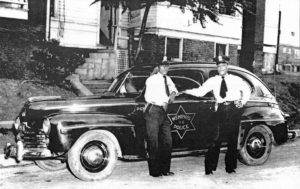MPD HISTORY
Established in 1827, the Memphis Police Department was built on a foundation of support, utility and loyalty to the City — just one month after its official incorporation.
1827
In 1827, John J. Balch was appointed town constable. This was the birth of the Memphis Police Department. Several years later, a town watch was created with two men paid $400 a year to work the night watch. The first police station was constructed. It was a 12′ by 20′ brick calaboose located at Main and Market, at a cost of $185. Rattles were purchased for the night watch. Yes, the first Memphis Police Officers carried big rattles that could be used as clubs.
The Department Grows
The Department grew rapidly, totaling twenty-one people. The City of Memphis was divided into districts and patrolmen were sent out in pairs. The Town Marshal was given the title of Chief of Police. After the end of the Civil War, a new, more efficient police force was organized on the basis of Wards instead of Districts. The Department increased in size by nearly 100 men.
1867
The first black men to serve with the Memphis police were a part of the Metropolitan force. William Cook and John F. Harris were hired on November 18, 1867, and served for about two years as turnkeys at the two district station houses.
1870s
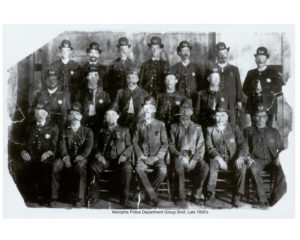
The decade of the 1870s was shaped by a deadly battle with a disease called “Yellow Jack.” Yellow fever struck Memphis in 1873 and again in 1878 and 1879. The police force was honored by the city council in 1873 for “remaining on duty” during the epidemic when most well-bodied individuals fled Memphis.
This was one of the noblest and proudest moments of the Memphis Police Department. Of the 55-man force, 50 were stricken with the fever, and 10 died.
The department hired another black officer in February 1878, Rufus H. McCain. The experience with Policeman McCain was so satisfactory that when white officers were lost to the disease, the number of black policemen were increased to a level proportionate with the black population of the city.
Fourteen other black officers were added to the force in August 1878. Most of these men stayed with the department for less than a year, but Townsend D. Jackson, Burrell Randolph, Moses Plummer, Howard Chastaine, and Dallas Lee all served as policemen over ten years.
The “Black Maria”

The first patrol wagon was purchased and was dubbed the “Black Maria.”
Early 1900s
In the early 1900s, the Department began working with 8-hour shifts. The first motor vehicles were purchased – one an ambulance, the other a patrol car. Barksdale Substation became operational. The emergency car was introduced, which consisted of 6 officers working 2 per shift responding to emergency calls. Police radios were installed in 12 police vehicles.
1930s
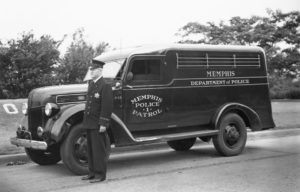
- In 1932, Memphis received international notoriety when it was named “The Murder Capital of the World.” There were 102 homicides that year.
- George “Machine Gun” Kelly was captured by Memphis Police Officers.
- The Police Academy was opened by Lt. Bill Raney, after his graduation from the FBI National Academy in 1937.
- The first riot squad was formed, consisting of 30 men who were trained in tear gas, rifles, and submachine guns.
- Police Officers gained civil service status.
1958
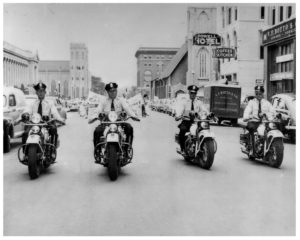
Armour Training Center was opened.
1960s
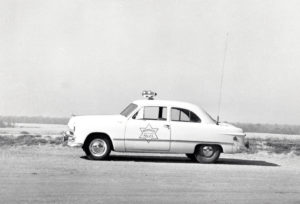
- In the early 60’s, the Emergency Squad was formed which contained 15 experienced and specially trained officers and the present Dog Squad was formed.
- Dr. Martin Luther King was killed in Memphis in 1968, causing riots and curfews.
- The first law enforcement planning agency was created by Detective Carl A. Goolsby.
1970s
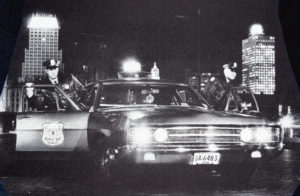
- In 1973, the department witnessed the formation of two police unions. The Afro-American Police Association was formed and the Memphis Police Association, a bargaining unit representing patrolmen and sergeants, was formed.
- In the summer of 1978 Memphis Police went on strike for eight days.
- The West Precinct opens at 247 Washington becoming the MPD’s fourth precinct.
Early 80s
- The Tact Unit rescued 3 doctors and one nurse held hostage during a 32-hour siege at St. Jude Research Hospital in 1982.
- Also in 1982, the Hostage Negotiating Team was formed.
- In 1982 the West Precinct moved from 247 Washington to its current location of 1925 Union Avenue.
- Hostage situation on Shannon Street resulted in eight deaths, including the police officer taken hostage. The year for that bloody assault was 1983.
Mid 80s
- In early 1984 the implementation of the Police Service Technician Program designed for the hiring of future commissioned police officers began.
- Specialized Patrol, a pilot program, was instituted to attack the problem of criminal activity using innovative techniques and tactics. Twenty officers and 2 lieutenants were divided into two eleven-man teams to target specific crimes in the city.
- Operation Involvement became fully operational in 1986, successfully implementing a program of developing mutual respect, cooperation, and understanding between the Memphis Police Department and the citizens of Memphis.
- Specialized Patrol made into a permanent unit. Formal institution of the career development program.
- The Department started operating four shifts to reduce response time during peak hours. The Delta Shift was implemented.
- The Neighborhood Watch Program was introduced within the Precincts. The first Police Open House was held.
- Beale Street Substation Museum was opened.
1988
- In 1988, the First Black Director was appointed, James E. Ivy.
- Central Precinct was opened, sharing space in the East Precinct until a permanent facility could be located.
- The state-of-the-art John D. Holt Training Academy opened.
- The Police Memorial Committee was formed and the first Police Memorial Service held.
- The Crisis Intervention Team was formed to respond to calls for assistance involving the mentally ill.
- Mendez Training Program implemented in Memphis City Schools, grades K-12. Peer Counselor Program started to provide a confidential source of support for fellow officers.
Early 90s
- As the ’90s began, the Family Trouble Center was opened at 620 S. Lauderdale, designed to attack the root causes of domestic violence.
- Cordova is annexed into the city and police services are provided.
- First Recruit Class is trained with the 9 MM pistol.
- The Emergency Vehicle Operation Course began operation at the Training Academy.
- In 1991, the TV show COPS was filmed in Memphis and the World Police and Fire Games were held.
- Eddie B. Adair was named first black Chief of Police in 1992.
- Computerization of the Memphis Police Department begins in the Robbery Squad and the Central Precinct opened August 15, 1992.
- First Police Summer Youth Camp for inner-city boys, ages 8-12, is held.
- 1993 brought the creation of the Downtown Precinct, which became the sixth precinct.
- The Tel-Serve reporting system becomes operational.
- MPD monthly newsletter “Behind the Badge” begins publication.
- The Field Training Officer Program was implemented in all six precincts.
- The Police Advisory Council was created to act as a liaison between the police and the community.
- A Computer Network links precincts to bureaus.
- Midnight Basketball program begins for at-risk males, ages 18-30.
- Burglary Squad created by the restructuring of Investigative Services.
Mid 90s
- In 1994, the COACT Unit was created and assigned to the Orange-Mound/Binghampton area to initiate new Community Policing Program. This program was expanded to Mississippi/Walker in the fall.
- The Memphis Police Sports Federation was formed to promote athletics within the Department.
- The Training Academy initiates “Freeze” pepper gas training for all officers. Seventy-five recruits graduate from the Training Academy as the largest class in Memphis Police Department history.
- Uniform Patrol divided into two districts containing 3 precincts each.
- Citizens Police Academy begins in the South Precinct as a nine-week training course for civilians.
- D.A.R.E. is launched in the Memphis City Schools with eight officers and 800 kids.
- Downtown Precinct Officers attend Bike Patrol School at Training Academy for full certification.
- Olander Franklin promoted to Chief Inspector, the first female to hold that position.
- As 1995 began, the anti-gang program G.R.E.A.T. joined D.A.R.E. in the city school system.
- COACT was expanded to the areas of Jefferson and Cleveland and Cooper-Young.
- A civilian, Kathy Todd, is promoted to Chief Administrative Officer over Administrative Services.
- The long-awaited Promotional process for sergeants and above begins and is scheduled for completion in the Spring of 1996.
- Weapons Watch, patterned after Crime Stoppers, is introduced within the city school system.
- Over 400 guns are confiscated in the first year.
- A new restraint device, the Ripp Hobble, is issued to all officers.
- In 1996, Walter J. Winfrey is named Director of Police Services by Mayor W.W. Herenton.
- COACT is expanded in the Westwood, Cooper-Young, and Jefferson-Cleveland areas. Westwood begins its Leaders of Tomorrow (LOT) program.
- Family Trouble Center moves to North Precinct and begins work on its Domestic Violence Pilot Project.
- Internal Affairs and Security Squad move to new offices in the 100 N. Main bldg.
- CrimeStoppers establishes a website on the Internet.
- HBO documentary “Memphis PD: War on the Streets” premieres. The America Undercover documentary takes an inside look at the emotional toll police work is exacting upon police officers.
- East and South Precincts hold their first “Back-to-School” supply giveaways to over 1,000 children.
- First Crime Prevention Merit Badge is awarded to the MPD Boy Scout troops by Director Winfrey.
- Promotional process completed in January of 1996 and the first officers in a large pool of sergeants, lieutenants, majors, and inspectors promoted in May.
1997
- In 1997, the Mounted Patrol was invited to participate in President Bill Clinton’s Second Inauguration in Washington, DC.
- Wellness Study started and conducted by the University of Tennessee Department of Preventative Medicine on bike officers and non-bike officers in the West Precinct. The study will monitor the officer’s stress levels over a 6 and 12-month period and is the first study of its type in the U.S.
- MPD begins its own hiring process, separate from City Hall Personnel, and utilizes print media, as well as, billboards as part of the recruiting effort.
- Bethel Labelle COACT opens in the East Precinct.
- 75th Recruit Class graduates 66 new police officers.
- Jackson Avenue COACT opens within the Hispanic area of Jackson and National. Several bilingual officers are assigned to this mini precinct.
- Street Crime Abatement Team (SCAT) formed. Made up of sergeants and TACT Unit officers this unit’s primary objective is to target specific street crimes and hot spot locations throughout the city.
- The MPD Accountability Plan – a quarterly report to Mayor Herenton – begins in February of 1997.
- Civilian Terrence Woods is appointed as Deputy Chief over Administrative Services.
- Director Winfrey and his Command Staff begin implementation of Strategic Action Management (SAM).
- Debby Hall is hired as the MPD’s new Media Relations spokesperson.
- MPD begins to implement the COMPSTAT program which is modeled after the NYPD’s successful computer crime analysis program. COMPSTAT spreads to each precinct and involves “report cards” that track crime within each precinct.
1998
- In 1998, Brenda Harris Jones becomes the first female to achieve the rank of Deputy Chief within the Memphis Police Department.
- The largest recruit class in MPD history graduates 113 new police officers on June 18, 1998, at Mississippi Boulevard Christian Church.
- Director Winfrey begins his monthly “Townhall Meetings.”
- Richard McBryde is appointed as the Executive Commander of Police Administration and will oversee Finance, Personnel, Communications, Administrative Services, and Information Systems.
- The Southeast precinct opens on July 1st at the now-closed Defense Depot on Airways. It is the MPD’s seventh precinct facility.
- Crisis Intervention Team members – Danny Parris, Debra Ham-Kelly, Sheryl Stanback and Roger Nelson – are recognized for ten years of service to the CIT program and for being CIT “pioneers” at the annual CIT Banquet.
- Orange Mound COACT opens in the Central Precinct in the first building built specifically for a COACT Unit.
- Graceland COACT opens in the South Precinct and Todd’s Creek COACT opens in the North Precinct.
- Over 900 kids attend 29 Anti-gang/Anti-drug summer camps sponsored by the MPD and the Black United Fund.
- The Sage SL-6 27mm L3AOS (Less Lethal Launched Ammunition Ordnance System) is implemented after CIT and Tact Officers received training in its use.
- Westwood COACT is recognized by the National League of Cities for Excellence in Community Policing.
- In December the largest recruit class in MPD history graduates 117 new officers.
- Binghampton COACT opens in the Lester Community Center.
1999
- Seven Officers from Chisinau Moldova visit the MPD in January of 1999 as part of an international exchange program sponsored by the International Association of Chiefs of Police. The Moldovan officers spend two weeks learning about the MPD. Seven Officers from Memphis travel to Chisinau for their two weeks of Moldovan training in February.
- In April of 1999, Director Walter Winfrey retires after 31 years of service. W.P. “Bill” Oldham is appointed Director by Mayor Herenton. Deputy Chief Dugger is appointed Deputy Director and Inspector Mike Dodd is promoted to Deputy Chief over Uniform Patrol District 1.
- In July, ground was broken for the Northeast Precinct which will be completed by the Spring of 2000. This precinct is lauded as a true “community” precinct and will have computer kiosks set up to allow citizens the opportunity to look up crime reports, traffic information and other MPD information.
- Hickory Hill COACT opened in the newly annexed area of Memphis. A capacity crowd attended the grand opening.
- The first Citizen’s Police Academy is held at the Hickory Hill COACT with a waiting list for the next class.
- Bike Patrols are expanded to the East Precinct and to the Hickory Hill area.
- Laptop computers are installed in the squad cars and officers receive training on their use.
- Mobile data beepers are tested in the field by bike officers, mounted patrol officers, and motorcycle officers. These “beepers” are used to run vehicle tag numbers, driver’s license numbers, and warrant checks.
- On December 7, 1999, Interim Director Bill Oldham retires after 27 years of service to the Memphis Police Department. Deputy Chief Walter E. Crews is named Interim Director by Mayor Willie Herenton.
- The Memphis Police Sports Federation inducts eleven officers into the newly unveiled Sports Federation Hall of Fame located in the Training Academy on April 10th.
2000
- After a 4-year drought brought on by lawsuits, 20 patrol officers were promoted to the rank of sergeant on February 24th, 2000.
- On June 8th, 2000 the 81st Basic Recruit Session graduated 34 new police officers.
- July 13, 2000, Mayor Herenton names Walter E. Crews as the permanent Director after a nationwide search.
- Director Crews appoints James H. Bolden as Deputy Director to replace Deputy Director David Dugger and names Dr. Rita Dorsey head of the Training Bureau. Deputy Chiefs Brenda Jones and Sam Moses retire and are replaced by Chuck Cook and Al Gray. Inspector Mary Wright is promoted to Chief Administrative Officer and replaces the retiring Richard McBryde.
- Forty-three lieutenants and 63 sergeants were promoted during a standing room only ceremony held at City Hall on July 12th, 2000. On the list of those getting promoted were several interesting pairs – mother and son ( Sgts. Dennis and Vertie McNeil); brothers (Sgts. Tim and William Green); sisters (Sgts. LaFrancine and Gayniece Bennett) and husband and wife (Lt. Michelle and Sgt. Jay Locastro).
- Northeast Precinct opens in August of 2000 as the MPD’s eighth precinct and the first newly constructed precinct facility in decades.
- The COP Team is formed in the fall of 2000. COP stands for Child Occupancy Protection and officers assigned to the COP Team check for properly installed child restraint seats and educates parents about child safety. The first two members of the COP Team were Officers Stoddard and Hawkins who received special National Highway Traffic Safety Administration training.
- Fall of 2000 the Memphis Police squad car takes on a new look as a new design is unveiled – the first new design since 1992. The bold red stripe and bright blue letters reading “POLICE” are designed to increase police visibility. This look, designed by Sgt. Susan Lowe, is also applied to the Crime Response Unit’s new mobile crime response van, as well as, 2 MPD Youth Program vans.
- The Missing Person/Juvenile Squad is formed in October of 2000 to investigate missing persons and juvenile runaways. The squad is comprised of retired officers, one full-time sergeant and a captain and is located at the Northeast Precinct.
- Director Crews announces in November that Occupational Nurse Carol Harriss and Finance Manager Chuck Fox will join the Administrative Services Division of the MPD. Nurse Harriss will be in charge of the MPD’s Hypertension Program as well as other OJI duties while Mr. Fox will manage the Finance Division.
2001
- In January of 2001, the Training Academy was the site of another standing room only crowd who gathered to watch 8 new inspectors and 22 new majors cross the auditorium stage to accept their new promotions.
- Officer Marco Yzguirre is designated as the first Latino Liaison for the Memphis Police Department in February of 2001. Officer Yzguirre hosts his first Latino Townhall meeting and over 1,400 Latino citizens attend.
- In the spring of 2001, Law Enforcement News names the MPD’s Crisis Intervention Team as its 2000 People of the Year.
- The Child Abuse Unit is moved into the newly renovated Child Advocacy Center on Poplar Ave.
- In 2001 the MPD became a liaison with YO Memphis (Youth Opportunity Movement), a nationwide initiative funded by the Department of Labor. During their annual awards ceremony, the MPD was recognized as one of YO Memphis’ outstanding partners.
- The East Precinct hosts the first Bi-Cultural Citizens Police Academy and graduates 30 new ambassadors in May of 2001.
- The MPD sends a large contingency of police athletes to the World Police & Fire Games in Indianapolis. They return with a slew of gold, silver and bronze medals.
- The East Precinct hosts the first 3-0n-3 “Taking it to the Rim” Basketball tournament and draws 2165 kids from 54 teams on August 11th, 2001.
- The Central Precinct hosts the first annual citywide Summer Safety Fair. Over 320 children from various community centers attended the day-long Fair.
- The Memphis Police Sports Federation inducts 21 officers into the Sports Federation Hall of Fame on October 6th. This is the second group of inductees for the Hall of Fame.
- The Brooks Road Substation opens on October 9th.
- Promotions are held in the Property Room on November 2nd as Alnita Campbell and Jackie Layrock are both promoted to supervisor after 19 years as property room attendants.
- Ground is broken on November 16th for the future home of the new Central Precinct which will be located on Tillman just North of Johnson. It is scheduled for completion in late 2002.
- On December 6, 2001, the Memphis Police Department welcomed 64 new Memphis Police Officers who graduated from the Training Academy as part of the 84th Basic Recruit Class.
2002
- Design work begins on the restoration of the old police headquarters located at 128 Adams. Plans call for the police department to relocate the executive, administrative and investigative offices in the historic building upon completion of the restoration project in late 2005, early 2006.
- In March of 2002, Deputy Director Bolden launched the P.R.E.P. Program designed to act as an introductory program for junior and senior high school students who wish to pursue a career in law enforcement.
- Director Crews and his Command Staff promoted three majors and 56 lieutenants on April 12th of 2002.
- The MPD welcomed 48 new police officers on June 20th during Basic Recruit graduation exercises held in Whitehaven.
- In the Fall of 2002, Director Crews announces the formation of the Juvenile Violence Abatement Project and appoints Dr. Rita Dorsey, commander of the Training Academy, as its project coordinator. Major Jimmy Kelly is selected as Training Academy commander.
2003
- In January of 2003, 246 police officers are promoted to the rank of sergeant – the largest promotional process in MPD history.
- In February of 2003, Director Crews announces his retirement after 33 plus years with the Memphis Police Department. Mayor Herenton taps Deputy Director James Bolden to be the next Director of Police Services pending confirmation by the City Council.
- In March of 2003, the Memphis City Council confirms James H. Bolden as the next Memphis Police Director.
- In the Spring of 2003 demolition work begins at 128 Adams – the historic police building that was abandoned in the 1980s – as the dream of finally restoring it to its former splendor becomes a reality. The renovation would begin in 2004 with a scheduled grand opening in the Summer/Fall of 2006. This renovated historic facility will not only house the MPD Command Staff and police personnel but also City Courts and their employees.
- Director Bolden presented his new management team on April 11th during a promotional ceremony in the Director’s Conference Room. Deputy Chief Ray Schwill was promoted to Deputy Director and will be in charge of the police department’s day-to-day operations. Director Bolden also promoted Inspector Janice Pilot of the North Precinct and Inspector Larry Godwin of Special Operations to Deputy Chief. Deputy Chief Pilot will be over Uniform Patrol District Two and Deputy Chief Godwin will oversee Special Operations. These two new Chiefs will fill vacancies that were created when Chief Schwill was promoted to Deputy Director and the retirement of Deputy Chief Mike Dodd. Inspector Mary Wright was also promoted to Deputy Chief and will remain in Administrative Services where her duties will remain the same. Chief Gray has been assigned to Investigative Services and Chief Cook will oversee Uniform Patrol District One.
- The Fraud & Document Unit changes its name to Economic Crimes Bureau as its investigative focus has expanded due to an increase in internet fraud and credit card and identity theft.
- The Central Precinct moves to a new state-of-the-art facility at 426 Tillman in July of 2003. The building, located in the heart of Binghampton, not only serves as a police precinct but also features community rooms and a computer lab for citizens and other city employees.
2004
- In August of 2004, Director Bolden and Deputy Director Schwill retired. Mayor Herenton appoints Larry Godwin to the position of Interim Director and Ernest Dobbins as Interim Deputy Director. On November 9th the City Council approved of the Mayor’s appointments of Director Godwin and Deputy Director Dobbins.
- On November 16th, 2004 Director Godwin and Deputy Director Dobbins made history when they promoted 4 new Deputy Chiefs. This was the first time that four Chiefs received their appointments at one time. The new Deputy Chiefs are Annette Taylor (Special Operations), Mike Lee (Investigative Services), Jim Tusant (Administrative Services) and Bobby Todd ( Uniform Patrol). These four new Chiefs join Deputy Chief Janice Pilot (Uniform Patrol) to fill out Director Godwin’s Command Staff.
- On December 2, 2004, the Department held a Medal Ceremony in the City Council Chambers at City Hall to honor 37 officers who had gone above and beyond the call of duty. Medals received by these brave officers included Life Saving, Medal of Valor, Medal of Merit and Medal of Honor.
- In a sign of unity, Director Godwin abolished the “white shirt “designation for command staff personnel and returned all commissioned officers to a unified blue shirt to foster a stronger team concept within the police department.
2005
- In January of 2005, positions in Special Operations were deleted to better utilize manpower based on need. Created a Street Crime Task Force within the Organized Crime Unit to address street crime from the ground level.
- In February of 2005, the squad car striping package was re-designed in order to save money on future vehicles and on those damaged by accidents or normal wear and tear. This provided a savings of approximately $300.00 per vehicle.
- In February 2005, the “Paperless Reporting Project” was completed. Officers in the field were issued a hand-held PDA unit that enables them to complete a TIBRS/NIBRS compliant offense report on a hand-held computer. Using a wireless connection to submit reports from the field this new device provides for a quicker submission of reports.
- During the spring of 2005, the Hispanic Action Team (HAT) was established in order to address crime and quality of life issues within the Hispanic Community.
- In April, Director Godwin and his Command Staff evaluated rank structure within the department and determined that operationally the rank of 30-year captain was unnecessary thus saving the Memphis Police Department 1.4 million dollars.
- The spring of 2005 saw the delivery for Fiscal Year ‘05 of one of the best budgets in Memphis Police Department history with a savings of over $950,000.00 in overtime expenses since August 4, 2004.
- The classification of the police vehicles for licensing was changed in the spring of 2005 which amounted to a savings of $18,000.00 for the next 5 years.
- In June of 2005, the MPD received final approval for the completion of the renovation of 128 Adams – the Memphis Police Department’s Historical Headquarters.
- The new Felony Assault Unit was launched in June of 2005, in order to aggressively investigate aggravated assaults in the same manner in which homicides, rapes and robberies are investigated.
- The MPD Command Staff sought and received approval from the City Council in June to install red-light cameras at various intersections throughout the city.
- The MPD secured, through a partnership with Memphis Light Gas and Water, a new facility for the Entertainment District Unit in the spring of 2005 with occupancy expected in late summer of 2005.
- A new partnership with the University of Memphis was created to establish an on-campus facility for the Reserve Bureau.
- Juvenile Violence Abatement Project (JVAP) was restructured in order to return its supervision and direction to law enforcement personnel.
- Returned the management of the COACT Units to the precinct level for better allocation of resources and structured accountability.
- In 2005 the names of each precinct (East Precinct to Mt. Moriah Station) were changed to better relate and identify with the communities served.
- In response to homeland security needs the MPD created the Memphis Police Department’s own Office of Homeland Security.
- Returned the management of the Public Information Office back to commissioned personnel.
- Returned Administrative Services to the command of a commissioned Deputy Chief.
- On June 17th, 2005, the first 94 of 165 new lieutenants were promoted at a ceremony held at the Cook Convention Center when these former sergeants received their new lieutenant badges and assignments. The remaining sergeants on the promotional list will be promoted to lieutenant within two years.
- Operation Blue CRUSH was launched in the fall of 2005 and was moved under the umbrella of the Organized Crime Unit evolving from a part-time operation to a full-time operation.
- Promotions for Inspector were held in September of 2005. The Major’s process was cancelled by City of Memphis Human Resources in November of 2005.
2006
- In 2006 delivered a $2 million surplus for Fiscal Year 2006 which includes a $730,000 surplus in overtime. This surplus is also the result of a hiring freeze for civilian positions.
- The MPD reduced Capital Improvements Budget Request in 2006 from $38.2 million to $5.3 million for the upcoming Fiscal Year 2007 by cutting the following projects: Police Headquarters Renovation, Impound Lot, Union Station Relocation, Traffic Precinct, Precinct Renovations, Academy Expansion, In-Car Video Project, Precinct Repave Project, South Main Station Relocation, Police Helicopter, and Radio Repair.
- In the Spring of 2006 redeployed manpower by eliminating non-essential units such as JVAP, Crime Education, and PREP and reduced staffing at DARE/GREAT (2 officers) and at the Boxing Gym (one Lieutenant). Also eliminated the position of Crime Information Officer at all Precincts and returned those patrol officers to the field.
- In the fall of 2006, a new unit was created – Criminal Apprehension Team (CAT) – to expand the resources of Operation Blue CRUSH, focusing on both problematic crime and known high crime areas inside the City of Memphis. The Criminal Apprehension Team encompasses the Hispanic Action Response Team and former members of the Metro Gang Unit working in conjunction with Project Safe Neighborhoods and the Auto Cargo Theft Task Force.
- Operation Blue CRUSH crime analysis process set up to involve MPD Comp Stat, the University of Memphis Center for Community Criminology and Research, Uniform Patrol, Investigative Services, and the Organized Crime Unit.
- Awarded First Place in the largest municipality category (2,001+ Officers) for enforcing traffic laws and protecting the public on occupant protection, impaired driving, and speeding in the 2006 National Law Enforcement Challenge sponsored by the International Association of Police Chiefs. In 2005, MPD placed second to LAPD. Director Godwin challenged our officers and in 2006, we took first place and LAPD took second to us.
2007
- Delivered over a $2 million surplus for Fiscal Year 2007. Received Council budget approval of $4.8 million to hire additional 126 new police officers in 2007.
- Received Council approval of $1.5 million to build and implement a new high-tech investigative tool called the Real-Time Crime Center.
- Promoted 2 Inspectors, bringing the rank to full complement.
- Added an additional Police Information Officer (PIO) in order to address the need for better public relations with the media and the community.
- Separated from the Shelby County Metro DUI Unit and increased officers from 9 to 18 to concentrate more resources on DUI enforcement inside the City of Memphis. This new unit, while enhancing visibility and protection for our citizens, increased DUI arrests and traffic enforcement by over 5%.
- Traffic has increased interstate visibility and traffic enforcement to lower traffic crash percentages and increase motorist safety.
- Opened the new Ridgeway Station Precinct and the new Dog Squad office.
- Launched Cyberwatch Pilot Program -The first phase of this program allows citizens to receive vital information relevant to their particular neighborhood by email notification. This information includes; offenses occurring, wanted parties, sex offenders and parolees. Citizens are encouraged to send in tips via email. Two additional phases will be forthcoming.
- Received National Accreditation from the Commission on Accreditation for Law Enforcement Agencies (CALEA). MPD placed in the top ten of large departments with a completion of 394 out of 400 standards.
- Hosted the 3rd National Crisis Intervention Team (CIT) Conference in 2007. The MPD continues to serve as the founding pioneer of this invaluable community tool.
2008
- In 2008 the MPD graduated 275 recruits from the Training Academy; over 2,800 applications reviewed for potential officers.
- Graduated 178 citizens from the Citizens Police Academy in 2008.
- Partnered with First Tennessee Bank and The Commercial Appeal to launch an Identity Theft campaign that included public awareness seminars, PSAs, and informational brochures.
- Launched the “Stow It! Don’t Show It” anti-theft campaign to combat thefts from vehicles.
- The Memphis Police Department officially launched its 2008-2009 Police Recruit campaign in October of 2008 aimed at aggressively recruiting new officers. The new advertising campaign was designed to attract qualified and dedicated individuals who want a career in law enforcement serving the City of Memphis. The unprecedented recruiting effort will continue for eighteen months to include remarkable TV, radio, print and online ads and bright and colorful billboards and bus shelter posters.
- MPD Recruiters visited 13 Memphis City high schools to talk to 11th and 12th graders about the Police Service Technician program and to hand out job applications.
- Graduated 18 Police Service Technicians from the Training Academy
- Received approval to implement 40 Traffic Crash Investigator positions in order to stabilize the complement of personnel available for minor crash investigations and to free up police officers for patrol duties. The new TCIs are slated to be hired in January of 2010.
- Promoted 4 Deputy Chiefs, 5 Colonels and 15 Majors to continue filling the upper-level management positions critical to ensuring accountability of department members.
- Much of 2008 has been spent in the development of other programs that will emerge from the RTCC in 2009. Among them are 3,000 Offender Tracking Bracelets for support of the criminal justice system in six counties in Tennessee, Mississippi, and Arkansas; the integration of the SkyCop camera system into the COBRA alarm system; and the development of License Plate Recognition (LPR) cameras. Seventy LPR vehicles and 40 fixed LPR Units will be placed into operation in 2009.
- Launched an online, web-based crime tip system for Crime Stoppers that will allow, for the first time, anonymous interaction between the tipsters and the police and give the MPD the capability of asking a tipster follow-up questions.
- Separated from the West Tennessee Drug Task Force and created the Interstate Criminal Interdiction Unit. Since the inception of the ICI Taskforce, over 325 pounds of marijuana, ¾ pound of cocaine, 2.4 pounds of methamphetamine, 15 vehicles, and $927, 172.00 has been confiscated by the taskforce.
- On November 3, 2008, Memphis Police Director Larry Godwin entered into a Memorandum of Understanding (MOU) with the Regional Counter Training Academy (RCTA) Meridian, MS agreeing that members of the Organized Crime Undercover Operations Unit would teach a two week highly intensive pass/fail (Over 120 Hrs.) Undercover Certification Course at the RCTA training facility in Meridian. Director Godwin agreed that the Memphis Police Department undercover staff would conduct three of these courses during the 2008 fiscal year staggered on a four-month timeline. To date 92 students including 9 Memphis Police Department Undercover Officers from, 12 states: AL, MS, GA, FL, LA, TX, TN, WI, MO, IN and KY have successfully completed this course.
- The Met Life Foundation honored the MPD’s Hollywood COACT and Rhodes College for significant accomplishments in reducing crime and improving the quality of life in the City of Memphis. The Neighborhood Revitalization Award sponsored by MetLife Foundation and administered by the Local Initiatives Support Corporation (LISC), recognized partnerships between community development groups and police departments that have reduced crime and spurred housing development, economic activity and improved community services in low-and moderate-income communities.
- The Memphis Police Foundation was formed in May 2008, as a 501(C)(3) non-profit organization, to provide private sector support to our police department and contribute to the development of an innovative, technologically advanced police force optimally engaged with the community it serves. Fifteen biracial board members have come together with great enthusiasm to leverage their expertise in the areas of finance, research, marketing, public relations, fundraising and development to build philanthropic support for our police department.
2009
- The MPD’s Real Time Crime Center was recognized in 2009 for Excellence in Law Enforcement Communications and Interoperability when the MPD won the top award for “excellence in law enforcement and information technology” at the 33rd annual International Association of Chiefs of Police Conference in Dallas, Texas.
- Director Larry Godwin was honored during a luncheon at The Peabody by the Rotary Club of Memphis East on August 5th when he was presented with the “Bobby Dunavant Non-Elected Public Servant Award”. The prestigious award, named after the late Bobby Dunavant who was the Probate Court Clerk for 21 years, is given to two recipients each year – one an elected public servant and the other a non-elected public servant. Award winners are selected based on the characteristics best displayed by Dunavant in the years he served the citizens of Memphis and Shelby County. Director Godwin joins an elite list of past honorees that include: Robert Lipscomb, Bill Gibbons, County Mayor A C Wharton, Judge Larry Potter and Bartlett Mayor Keith McDonald. City Councilman Bill Boyd joins that list this year with Director Godwin as the recipient of the “Elected Public Servant” award.
- The Memphis Police Department was the recipient of two special awards on October 14th at the 2009 Vox Awards sponsored by the Memphis chapter of the Public Relations Society of America (PRSA). The MPD was recognized in the “Public Service” category for two different media campaigns and received the top award – called the Vox – for the 2008-2010 MPD Recruitment Campaign and the 2009 “Memphis Fights Financial Fraud” Campaign with First Tennessee Bank.
2010
- The Memphis Police Department was recognized in New Orleans in July of 2010 during the Project Safe Neighborhoods Conference. The MPD received the Outstanding Local Training Program Award for developing and administering a series of training programs designed to improve the quality of officers’ criminal investigations, case documentation and courtroom presentations. The training was initially constructed for the Memphis Police Department’s Organized Crime Unit In-Service training and used actual case reports and warrants that the drug and vice teams had prepared. AUSA’s and District Attorneys conducted mock suppression hearings, trials, and lectured for eight-hour blocks each week for four consecutive weeks. The training was then adapted for an Undercover Operations School conducted by the Memphis Police Department, which involved officers from across the country.
- On the heels of the National Project Safe Neighborhoods award, the Memphis Police Department received a National Award from Nucleus Research on July 21st. The Memphis Police Department was one of only ten companies and governmental agencies to receive the 2010 Nucleus Research ROI award. Out of 350 technology projects that were submitted, the Memphis Police Department was one of only two governmental agencies to receive an award. The other governmental agency was the US State Department. The ROI (Return On Investment) award is based on the company’s or government agency’s return on investment from their use of technology. SPSS software is used at the Memphis Police Department Real Time Crime Center for analyzing crime data to assist with the Blue Crush initiatives including “hot spot” policing and deployment of officers. Blue CRUSH has greatly expanded over the years and now works in tandem with MPD’s Real Time Crime Center (RTCC), a $3 million state-of-the-art crime monitoring and analysis hub that opened in June 2008.
- In September of 2010, two British police forces have begun to implement Blue CRUSH™ after seeing how the Memphis Police Department was able to see a 31 percent reduction in overall crime and a 15 percent fall in violent crime. The system has also been credited with improving morale among officers of the Memphis police by boosting arrest rates and helping them to feel as if they are “making a difference.”
2011
In April of 2011, Director Godwin retired. Mayor Wharton appoints Toney Armstrong to the position of Director of Police Services. City Council unanimously approved the Mayor’s appointment of Director Toney Armstrong

